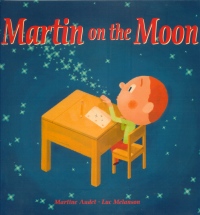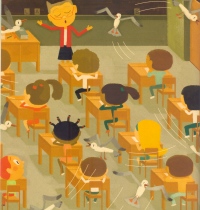| ________________
CM . . . . Volume XVIII Number 39 . . . . June 8, 2012

 |
Martin on the Moon.
Martine Audet. Illustrated by Luc Melanson. Translated by Sarah Quinn.
Toronto, ON: Owlkids Books, 2012.
32 pp., hardcover, $16.95.
ISBN 978-1-926973-16-6.
Preschool-grade 2 / Ages 4-7.
Review by Megan Sorenson.
***½ /4
|
| |
|

excerpt:
I concentrate really hard, but the blackboard is still empty. The teacher is waving her arms around, talking with her hands. She looks like one of those seagulls that flies along the riverbanks, or one of those other birds that sits on the rock waiting for its wings to dry. They cry out, they play in the air, and then suddenly they dive down to catch fish.
I miss those times.
I miss the waves and the wind.
I even miss the rain.
Amid the crowd of picture books that depict a child’s first day of school, Martin on the Moon (an English translation of Xavier-La-Lune) stands out as a beautiful, whimsical, and unconventional offering. 
Martin knows that school is a place for serious learning, but, while he valiantly tries to concentrate on what is going on in the classroom, his thoughts keep taking off in entirely different directions. Each new person or object reminds him of the people and places he already knows, and what follows is a kind of exuberant stream of consciousness tour through the people, places, and things that occupy Martin’s heart and imagination: Mum Mum, his cat “Happy,” the river he saw on vacation, his friend Athena’s laughter, and butterfly kisses. But when his teacher catches him mid-daydream, Martin is unsure how the class will respond if he shares his ideas.
The flow of the narrative is unique, with Martin moving quickly from one memory to another, but, somehow, it really works. In fact, this enthusiastic outpouring of different impressions and thoughts succeeds in creating a more realistic and childlike voice than any perfectly structured narrative would. On the level of language, the text contains a number of vivid word pictures, which demonstrate the love of imagery that Martin has inherited from his poet mother. The entire text reads like a poem in free verse.
Themes of individuality, love, poetry, and imagination are skilfully blended together in this story. One of the loveliest aspects of the text is how it quietly but persistently affirms the importance of children’s exploration, wonder, and excitement. While most first-day-of-school stories attempt to address children’s fears about whether or not they will make friends, Martin on the Moon speaks to some more complex questions: can a child’s individual experiences and ideas be valued and supported in a classroom setting? Can imagination play a role in education? Martine Audet’s narrative gives a resounding yes on both counts, providing readers with a thoroughly satisfying conclusion that adeptly avoids clichés or didacticism.
Luc Melanson’s illustrations are full of high contrasts and rich colours that will appeal to children and adults alike. While the book’s full page spreads and spot illustrations appear to be digitally rendered, they have a very painterly look to them. Where Melanson really shines, however, is in the way that he blends the schoolroom reality with Martin’s daydreams to create evocative and often fantastical images. Seagulls soar in the classroom, rows of desks materialize on the edge of the river, and a giant moon lands on Martin’s desk. The way in which the illustrations extend and illuminate the text is extremely effective, particularly when the narrative touches on abstract concepts, such as poetry or imagination. There is also a decidedly playful element to Melanson’s images. For example, where the text only mentions that Ms. Fisher’s hair is the same shade of grey as Happy’s fur, Melanson also gives the teacher some cat-like green eyes and a spiky hairstyle that looks suspiciously like feline ears. Child readers will have a lot of fun pointing out the parts of the picture that might be considered “make-believe.”
While Martin on the Moon will be best suited to parent-child lap time, it also has potential as a read-aloud for larger groups.
Highly Recommended.
Megan Sorenson is an MLIS student at the School of Library, Archival and Information Studies in Vancouver, BC.

To comment
on this title or this review, send mail to cm@umanitoba.ca.
Copyright © the Manitoba Library Association. Reproduction for personal
use is permitted only if this copyright notice is maintained. Any
other reproduction is prohibited without permission.
NEXT REVIEW |
TABLE OF CONTENTS FOR THIS ISSUE
- June 8, 2012.
AUTHORS |
TITLES |
MEDIA REVIEWS |
PROFILES |
BACK ISSUES |
SEARCH |
CMARCHIVE |
HOME |

